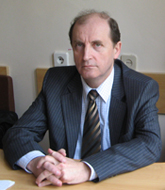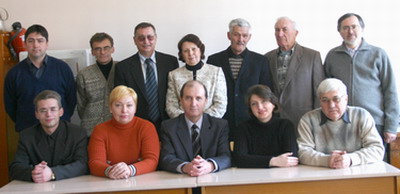 It was established in 1972 by Professor A.S. Khlystov It was established in 1972 by Professor A.S. Khlystov
The Head of the Department is Associate Professor M.B. Strugatskiy
Teaching staff:
Professor A.V. Yatsenko ( Nuclear magnetic resonance in solids, Radioscopy of solids)
Associate Professors: M.B. Strugatsky (Physics of semiconductors and dielectrics, Crystal physics, Magnetic characteristics of solids), A.K. Pankratov ( Crystallography, Physics of metals, X-ray structure anlysis), N.I. Karpenko ( Information processing devices) and E.M. Maksimova ( Oscillatory spectroscopy, Numerical methods in physics), A.V. Sapiga ( Electricity and magnetism, Computer methods in physics); Senior Lecturers: V. A.Chuklov ( Electricity and magnetism, Optics), S.V.Yagupov ( Crystal growth, Modern methods of crystal synthesis), A.Y. Khrenov ( Oscillatory spectroscopy, Physics of semiconductors and dielectrics).
Profile of Specialists:
Students graduate as specialists in structure and physical characteristics of solids, experimental methods of solid-state research (X-ray structure analysis, radio and optical spectroscopy, magnetooptics, magnetic metering , etc.) as well as modern methods of crystal synthesis.
Educational and scientific sections:
radioscopy laboratory, X-ray structure analysis laboratory. X-ray structure analysis laboratory, crystal growth laboratory.
Areas of research:
 Research of the structure and physical qualities of magneto-ranked crystals, surface magnetism, magneto-acoustics of antiferromagnetics, research of structure and physical qualities of segneto-electric materials, development of equipment for experiments ( nuclear magnetic resonance, electro metrics, magneto metrics, growth of crystals), research of structure and physical qualities of porous aluminum silicate (zeolites), development of technologies of mono crystal Ferro dielectric growth, growth of profiled mono crystals of leucosapphires, applied magneto-optics (development of equipment and devices for optic information and communication processing on the basis of magneto-optic systems).
Research of the structure and physical qualities of magneto-ranked crystals, surface magnetism, magneto-acoustics of antiferromagnetics, research of structure and physical qualities of segneto-electric materials, development of equipment for experiments ( nuclear magnetic resonance, electro metrics, magneto metrics, growth of crystals), research of structure and physical qualities of porous aluminum silicate (zeolites), development of technologies of mono crystal Ferro dielectric growth, growth of profiled mono crystals of leucosapphires, applied magneto-optics (development of equipment and devices for optic information and communication processing on the basis of magneto-optic systems).
Academic and educational relations:
are maintained with the NASA Institutes ( the Institute of Radioelectronics, Donetsk Physiotechnical Institute and the Institute of Monocrystals), the Ukrainian State Institute of Mineral Resources, Moscow, St. Petersburg, Krasnoyarsk, Tomsk ( Russia), Yerevan ( Armenia), Vienna
( Austria) and Szczecin ( Poland) Universities, the RAS Institutes ( Institute of General Physics , the Institute of Physical Problems, the Institute of Physicotechnical and Radiotechnical Metering, the Institute of Physics at the RAS Siberian Division, Kurchatov Institute, the Research Institute for Physicotechnical and Radiotechnical Metering, the Institute of Silicate Chemistry, the Institute of Metal Physics at the RAS Ural Division). |